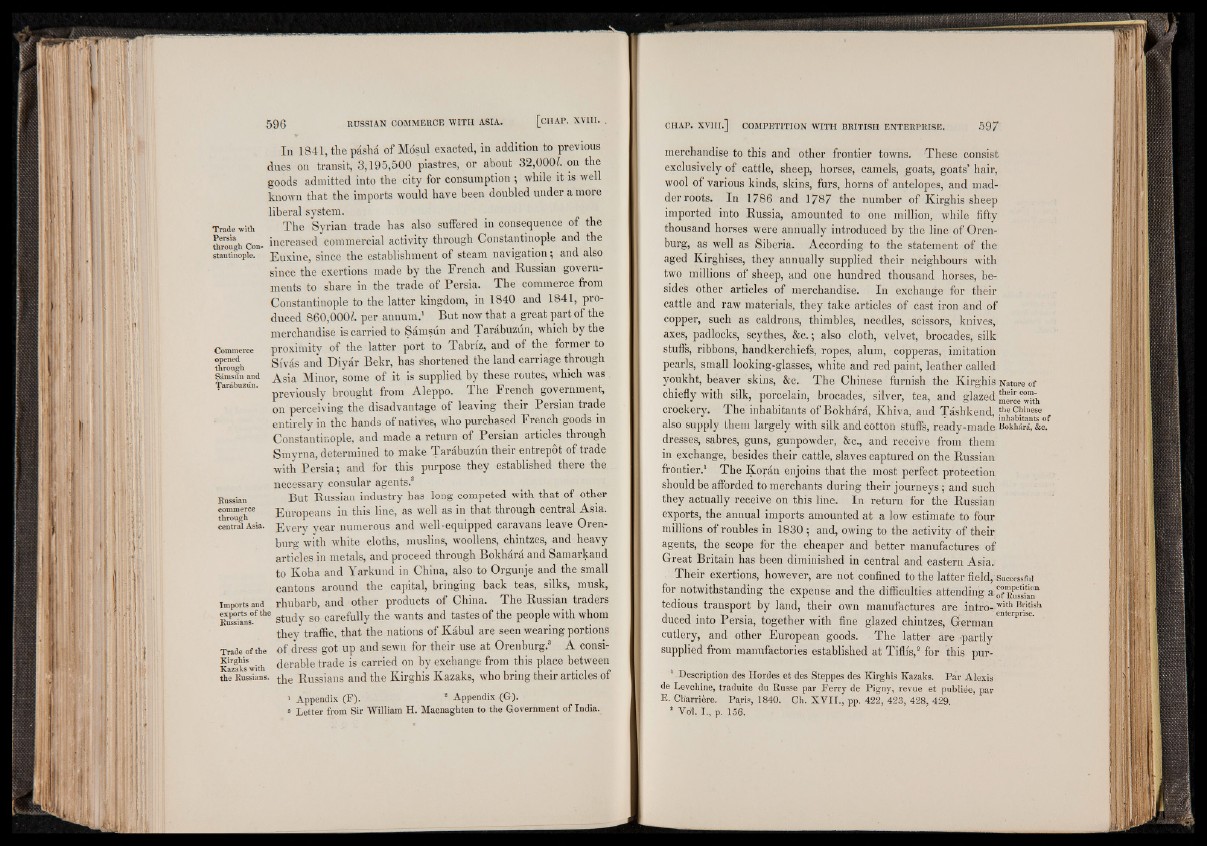
In 1841, the pasha of Mosul exacted, in addition to previous
dues on transit, 3,195,500 piastres, or about 32.000Z. on the
goods admitted into the city for consumption ; while it is well
known that the imports would have been doubled under a more
liberal system.
Trade-with The Syrian trade has also suffered in consequence of the
Persia increased commercial activity through Constantinople and the wrougn con* • • J l
stantinopie. Euxine, since the establishment of steam navigation; ana also
since the exertions made by the French and Russian governments
to share in the trade of Persia. The commerce from
Constantinople to the latter kingdom, in 1840 and 1841, produced
860,000Z. per annum.1 But now that a great part of the
merchandise is carried to Samsun and Tarabuzun, which by the
Commerce proximity of the latter port to Tabriz, and of the former to
throifh Sivas and Diyar Bekr, has shortened the land carriage through
Samsun and Asia, Minor, some of it is supplied by these routes, which was
Tarabuzun. brought from Aleppo. The French government,
on perceiving the disadvantage of leaving their Persian trade
entirely in the hands of natives, who purchased French goods in
Constantinople, and made a return of Persian articles through
Smyrna, determined to make Tarabuzun their entrepot of trade
with Persia; and for this purpose they established there the
necessary consular agents.8
Russian But Russian industry has long competed with that of other
— rec Europeans in this line, as well as in that through central Asia,
central Asia. Every year numerous and well-equipped caravans leave Orenburg
with white cloths, muslins, woollens, chintzes, and heavy
articles in metals, and proceed through Bokhara and Samarkand
to Koha and Yarkuud in China, also to Orgunje and the small
cantons around the capital, bringing back teas, silks, musk,
Imports and rhubarb, and other products of China. The Russian traders
R i £ s ° fth e study so carefully the wants and tastes of the people with whom
they traffic, that the nations of Kabul are seen wearing portions
T ra d e O f the of dress got up and sewn for their use at Orenburg.3 A consi-
K2Swith derable trade is carried on by exchange from this place between
the Russians. tbe Russians and the Kirghis Kazaks, who bring their articles of
1 Appendix (F). s Appendix (G).
8 Letter from Sir William H. Macnaghten to the Government of India.
merchandise to this and other frontier towns. These consist
exclusively of cattle, sheep, horses, camels, goats, goats’ hair,
wool of various kinds, skins, furs, horns of antelopes, and madder
roots. In 1786 and 1787 the number of Kirghis sheep
imported into Russia, amounted to one million, while fifty
thousand horses were annually introduced by the line of Orenburg,
as well as Siberia. According to the statement of the
aged Kirghises, they annually supplied their neighbours with
two millions of sheep, and one hundred thousand horses, besides
other articles of merchandise. In exchange for their
cattle and raw materials, they take articles of cast iron and of
copper, such as caldrons, thimbles, needles, scissors, knives,
axes, padlocks, scythes, &c. ; also cloth, velvet, brocades, silk
stuffs, ribbons, handkerchiefs, ropes, alum, copperas, imitation
pearls, small looking-glasses, white and red paint, leather called
youkht, beaver skins, &c. The Chinese furnish the Kirghis Nature of
chiefly with silk, porcelain, brocades, silver, tea, and glazed
crockery. The inhabitants of Bokhara, Khiva, aud Tâshkend, ^abim Tof
also supply them largely with silk and cotton stuffs, ready-made Bokhara, &c.
dresses, sabres, guns, gunpowder, &c., and receive from them
in exchange, besides their cattle, slaves captured on the Russian
frontier.1 The Koran enjoins that the most perfect protection
should be afforded to merchants daring their journeys ; and such
they actually receive on this line. In return for the Russian
exports, the annual imports amounted at a low estimate to four
millions of roubles in 1830 ; and, owing to the activity of their
agents, the scope for the cheaper and better manufactures of
Great Britain has been diminished in central and eastern Asia.
Their exertions, however, are not confined to the latter field, .Successful
for notwithstanding the expense and the difficulties attending a Inhïsë&n
tedious transport by land, their own manufactures are i n t r o - w i t h B r i t i s h
l i • i T» • i • i . enterprise. duced into Persia, together with fine glazed chintzes, German
cutlery, and other European goods. The latter are -partly
supplied from manufactories established at Tiflis,2 for this pur-
1 Description des Hordes et des Steppes des Kirghis Kazaks. Par Alexis
de Levchine, traduite du Russe par Ferry de Pigny, revue et publiée, par
E. Ch'arrière. Paris, 1840. Ch. XVII., pp. 422, 423, 428, 429.
* Veil, I , p. 156.